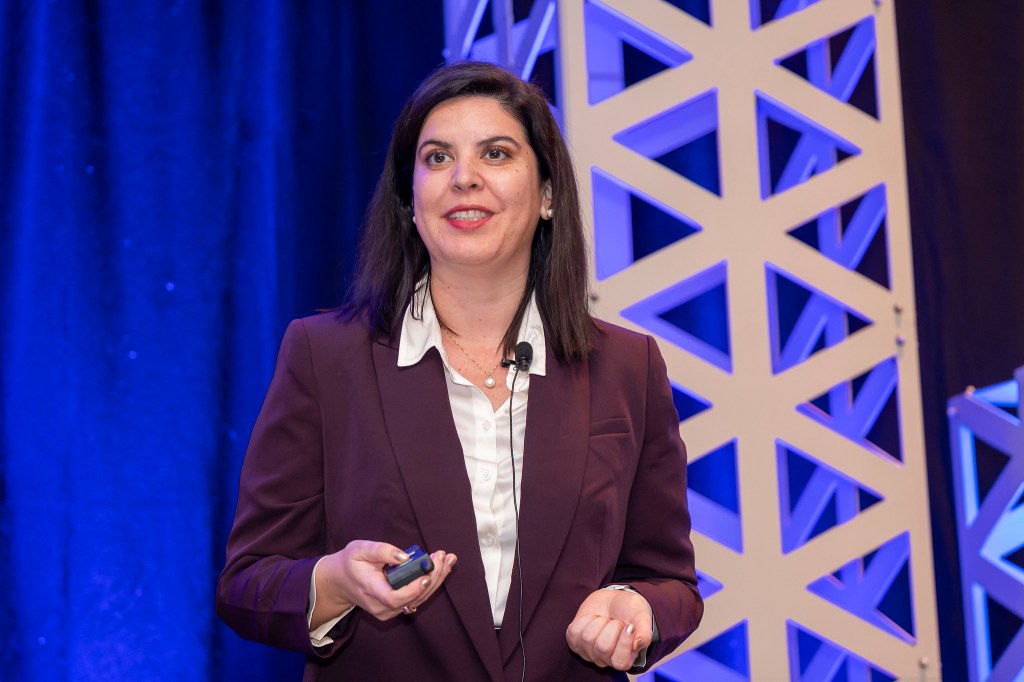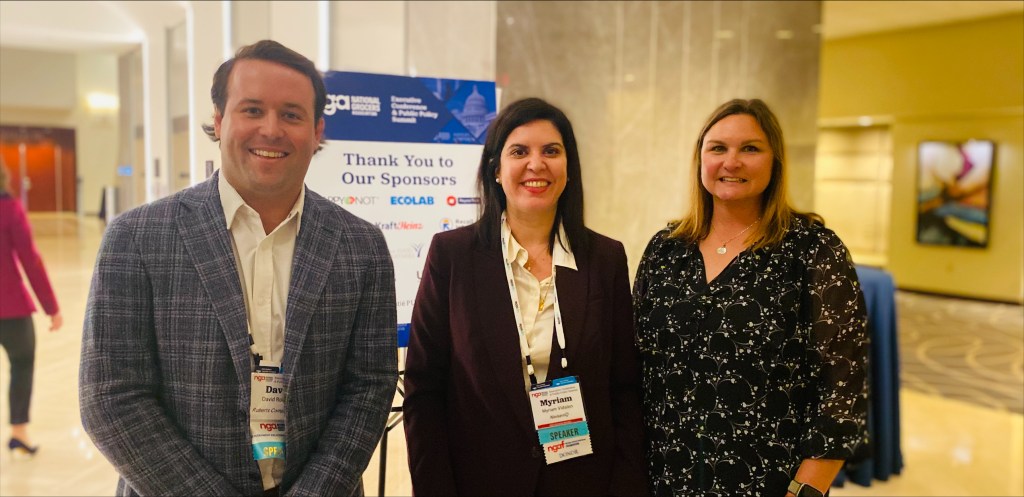Winning the battle for talent
As retail businesses relentlessly confront the familiar foes of labor shortages and turnover, Myriam Vidalon, NielsenIQ’s Chief Diversity, Talent and Culture Officer, recently presented new insights on how organizations can leverage the full potential of a multigenerational workforce by “consumerizing” the employee experience to enhance engagement and drive results.
The persistent inflationary climate, lingering supply chain disruptions, high turnover rates and related labor challenges are compounding the complexities required to win the battle for talent in the realm of today’s multigenerational workforce, according to Vidalon, who delivered a keynote address at the National Grocers Association’s (NGA) Executive Conference & Public Policy Summit in Washington, D.C., late last year. Following her presentation, Vidalon interviewed emerging retail grocery leaders Ashley Harris, VP of finance at Memphis, Tenn.-based Superlo Foods and David Roberts, a third-generation member of Hattiesburg, Miss.-based Roberts Co.’s leadership team, both of whom affirmed the important role multigenerational employees play in their companies.

“Quiet-quitting” comes into view
Further exacerbating the perennial challenge of turnover across all industries, according to Vidalon, is the viral “quiet quitting” trend, which refers to the practice of doing only the most basic, bare-minimum tasks while being present at one’s place of employment — albeit being disengaged and psychologically detached.
Be it a genuine workplace trend or a fleeting social media phase, Vidalon said the rise of quiet quitting “coincides with the current US employee engagement levels taking a back step in the second quarter of 2022, showing the lowest level of engagement in the US workforce in almost a decade. Not surprisingly, this drop in engagement has been concurrent with the rise in job resignations across the nation,” she added.
The foremost challenge before all employers today, Vidalon affirmed, “is building highly engaging workplaces to stem employee turnover” at a time when improved working conditions, declining birth rates and extended life expectancies have combined to produce a very nuanced workplace. “Today, for the first time in American history, four generations, each with a unique set of characteristics and needs, are working side-by-side.”
“Consumerizing” the employee experience
The unprecedented generational diversity and tenuous labor market defining the current employment landscape have sparked a new workplace dynamic in which choice plays a pivotal role “with how employees are evaluating your offering as an employer just as a customer evaluates your stores, products and services.”
To that end, Vidalon believes “more deliberate efforts must be made to ‘consumerize’ the employee experience to increase employee satisfaction and engagement while driving financial outcomes.
“Every interaction between an employer and employee becomes a touchpoint—their tenure with your company becomes their customer journey,” explained Vidalon. “Simply put, their employee experience becomes their customer experience and the resulting effects of how the employee interacts with your company translates into their engagement and ultimately, their decision to stay with you or leave you.”
Vidalon believes the importance of nurturing and perfecting the employee experience cannot be understated. “These same employees are also your customers — in most cases, members of the communities your stores serve — and represent the neighborhood’s diverse set of cultures and backgrounds.”

Advancing multigenerational workforce engagement
Key to Vidalon’s message was a discussion of how NielsenIQ strives to meet employees’ needs with a three-step framework that she said “has yielded above-average engagement scores in just 10 months by training our leaders to embrace a unified vision” as follows.
Create clarity: “At a foundational level, employees need to be clear about the expectations of their role and how their work connects to the overall priorities of your organization,” she said. Importantly, employees should know how their role contributes to making their workplace successful and have a clear picture of the business goals and how their role is integral to helping achieve them.
Additionally, employees need clarity on what you stand for as an organization. “Do you stand for increasing profits or do you stand for improving lives by making healthy food available to everyone?”
Citing NielsenIQ consumer research which underscores an awakening of a social conscious and concern for well-being, not only for oneself and their families but also for the community where one operates, Vidalon said: “Employees expect to contribute to a larger mission and they want to know their work makes them feel their job is important. You can create that connection by knowing what your employees care about.”
Focus on people: Vidalon said younger workers have declined significantly in feeling cared about, primarily by their manager. Her advice is to “focus on people, which starts by having leaders who know their employees as individuals,” and which is best achieved with regular 15-30 minute, one-on-one conversations to demonstrate empathy with a human touch.
Recognition is another key, Vidalon shared. “When we kicked off a peer-to-peer recognition program at NIQ, we tripled the number of employees feeling recognized for their work, increasing overall engagement. We saw people posting their certificates on LinkedIn as well as improvements in inter-departmental collaboration.”
Vidalon also cited data which finds that employees who work for an organization with a system to recognize life events (birthdays, weddings, personal milestones, etc.) are twice as likely to be thriving at work vs. those who don’t.
Soliciting input is another a crucial component of feeling valued and included, she affirmed. “Your employees are close to the customer, so their ideas can bring value to problem-solving. When people feel involved in making the decision, they will have a sense of responsibility and ownership for the process.”
Building quality-focused teams: Central to the goal of elevating engagement “are visible metrics employees can see to show them how they are progressing against goals at both the organizational and store-level. Employees feel a sense of ownership and they like seeing their team driving impactful outcomes. This also builds teams that are more committed to quality.”
Employees also want feedback. As such, all managers must be properly trained on how to give feedback “in a way that helps the employee grow and develop. Feedback must be timely, and it shows employees you are invested in their growth. Employees want opportunities to learn and grow their careers,” said Vidalon, who challenged her audience to ask themselves how they can build visibility into opportunities. “Do they have a path with you? What are the possibilities for learning? Is mentoring an opportunity for employees you see as high potential?”
Knowing your employees is key
All employees have similar needs which manifest in slightly different ways. To that end, Vidalon offers the following recommendations to help employers better understand the current trends and engagement strategies within their own organizations:
- Don’t discount the impact of managers on the experience of employees.
- Measure and develop your managers accordingly.
- Don’t ask overall employee satisfaction questions. Instead, ask questions which will help you measure actual engagement and further help management improve your employee’s interaction.
- Build an operating rhythm to create a highly engaged workforce where leaders are routinely coached to put into practice:
- Clarity of expectations: Purpose and mission
- People-focus: Care and empathy, recognition and input
- Opportunities to drive results through: Ongoing feedback, opportunities for career development and colleagues’ commitment to quality.
Integral to the employee engagement process, according to Vidalon, is infusing a culture of open, honest, transparent communication to build an atmosphere where people feel included and respected. This provides a positive employee experience and enables individuals of all generations to fulfill both their professional and personal needs, and above all, their full potential.



